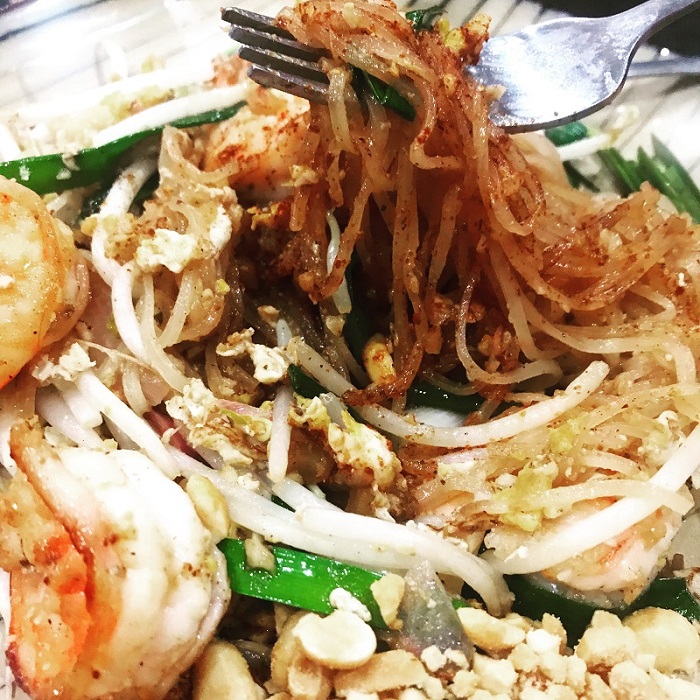Ah, the iconic Pad Thai … one of my favorite Thai dishes of all time and my measure of authenticity of Thai restaurants. For many people this is the gateway into Thai cuisine, and rightly so – Pad Thai is one of the most approachable dishes in the repertoire of Thai food. I often get asked if people in Thailand actually eat Pad Thai, and the answer is emphatically “Yes!” – Pad Thai is popular in Thailand as much as it is outside of Thailand.
When done right, Pad Thai strikes a balance between the three primary flavors of sour, sweet, and salty achieved through a combination of tamarind, palm sugar, and fish sauce. The end result is an awesome plate of chewy noodle, contrasted with crunchy bean sprouts and peanuts, and spice (if you wish) from added grounded chilis.
Surprisingly, Pad Thai is not a difficult dish to make, which is why I am continually perplexed at the lack of good Pad Thai outside of Thailand. I’m not exaggerating when I say most Thai restaurants (yes legit ones run by Thai people with Thai cooks) make terrible Pad Thai. The most egregious fault is that it is usually too sweet – off balance for a dish that is all about striking balance. Shame. Perhaps they are trying to cater to a Western palate that favors a sweeter note.
So here we are – for those of us who want good authentic Pad Thai, the kind you find in Thailand, this post is for you. The recipe here represents the way Pad Thai is made in the motherland with ingredients that are used in text book Pad Thai.
Now having said that, I understand that depending on where you live, some ingredients may not be readily available. Or if you’re like me, you may not like some of the components (we’ll talk about how much I hate tofu in another post). If you frequently order Pad Thai in restaurants, you know there tends to be variation of what is in it. So not having all the ingredients won’t necessarily ruin the dish. The key to good Pad Thai, however, is the Pad Thai sauce. Get this right, and you can omit or substitute away some components and it will still taste like Pad Thai.
The sauce is made up of three ingredients (tamarind, palm sugar, fish sauce), which unfortunately I feel only 1 can be substituted – you can substitute white sugar for palm sugar. The other two are so central to the flavor that makes Pad Thai what it is (like you can’t really have carbonara without eggs, or margarita without tequila… you can try to substitute but it won’t be what it’s supposed to be – you get me?) Fortunately, you can get all of these ingredients online; so if you are dead set on making legit Pad Thai, then Amazon might be your first stop.
Last note – you should make Pad Thai one portion at a time. Trying to make a large batch all at once will not be as good. Serve your Pad Thai with an extra side of bean sprouts, peanuts, a wedge of lime, and some chili flakes or grounded Thai chili powder. Use chopsticks if you must, but in Thailand we use a fork and spoon.
I’m getting a little hungry now, so let’s get cooking!
About the Ingredients
Rice Noodles
Pad Thai is typically made with medium size rice noodles, which are easy to find at most super markets. I often use a skinnier noodle but that’s just my preference. You can buy rice noodles fresh or dry. If you buy dry noodles, you will need to soak them in warm water for about 30-60 mins to rehydrate them, making them soft and pliable again. Once rehydrated, you can toss them right into the pan.
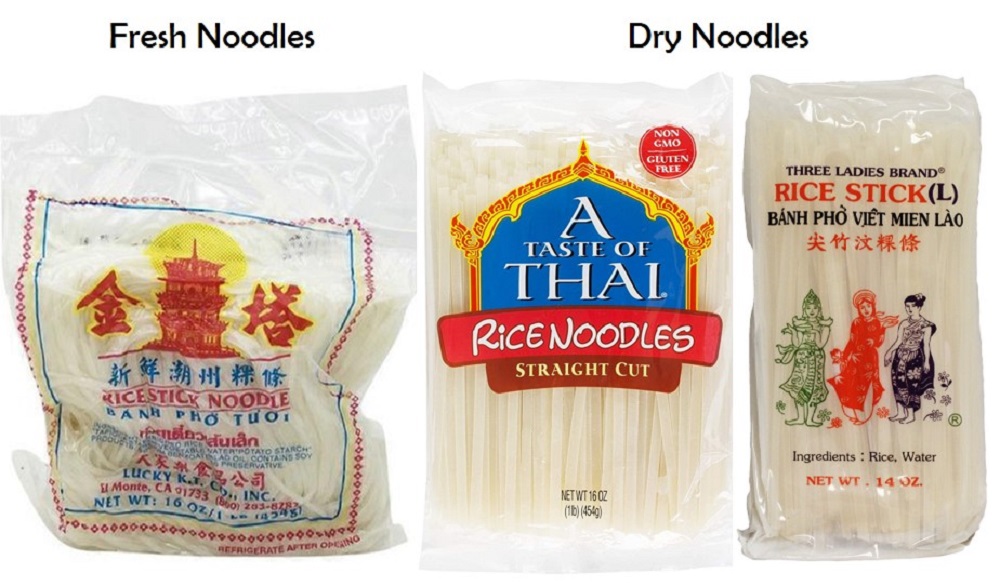
Tamarind
Tamarind is a fruit widely grown in warm, wet regions of the world (Asia, Central/South America). The pulp of the tamarind is usually diluted in water to create a paste or liquid (of varying consistency) then added to drinks, soups, curries, and other dishes. It is a widely used ingredient in many Asian, Indian, and Latin dishes to add a fruity sour tanginess without the citrus notes.
You can buy tamarind in three main forms: pulp, paste, or concentrate. Pulp form (may have seeds or be seedless) comes in square blocks, while pastes and concentrates often come in a jar. If you buy pulp, you will need to do a little prep work first. To prepare pulp, break of a chunk from the block and soak in hot water for about 30 minutes. The pulp will start to break up and loosen; at this stage remove any seeds. Then take your hand and squeeze and squish the pulp in the water until you have a thick liquid concentrate, then strain through a sieve to remove all the pulp. The thickness of the concentrate will depend on how much water you’ve used.
To save from all this work, you can look for tamarind concentrate! Mexican, Indian, and many other Asian cuisines use tamarind so this should not be too difficult to find. Of course, if all else fails, you can find it online. I am most familiar with brands from Thailand so that’s what I would recommend for my recipes.
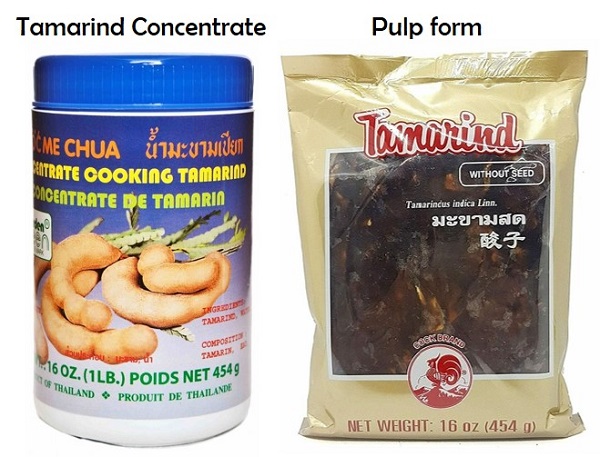
Preserved Raddish
This is probably the most difficult ingredient to find in this recipe. Some Chinese grocery stores may have it; my local Chinese grocer doesn’t. I’ve only see this at a Thai grocer, which I know may not be an option for many people. Because it is difficult to find, I often leave it out and you can too. Having said that, you can order this on Amazon if you really want to go the whole nine yards. Make sure you get the “sweet” (not “salty”) variety. It adds another layer of flavor and texture to the overall dish. There is really no good substitute for this so just leave it out if you can’t get it.

Dried Shrimp
This is another common ingredient in Thai cuisine. Dry shrimp is like beef jerky (so shrimp jerky I guess?). Its texture is like beef jerky – chewy, salty, and has a concentrated flavor. But unlike beef jerky, you don’t snack on it on long road trips (or ever :lol:). Depending on how “dry” the brand you bought is (not all dry shrimp are created equal), you will likely want to chop these up into small tiny pieces. It provides a boost of umami to this dish. Having said that, you don’t need to use it if you don’t want to. I leave it out all the time when I make Pad Thai.

Firm Tofu
First let me preface this by saying (full transparency), that I am the last person on earth who you should ask about tofu. I absolutely hate tofu, hate hate hate …. hated it since the day I was born. You will not find many recipes on this site that involves tofu (hey, we cook what I like to eat, right?). Having said that, I am including it here as it is a component of authentic pad thai – even though I always omit it, and will request my pad thai to be sans tofu in restaurants, and if they ever do appear in my order, I will unapologetically pick them all out. That’s right; I’m not ashamed at all.
Now, if you do wish to add tofu to your pad thai, make sure you get the right kind of tofu – you will need a firm tofu that can be sliced and withstand stir-frying. So look for “pressed” tofu, or firm tofu or extra firm tofu.
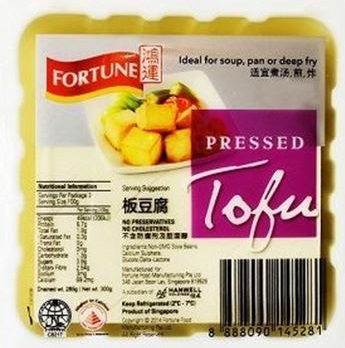
Garlic Chives
Not to be confused with onion chive (the chive you put on baked potato, soups, and French dishes). The most immediately noticeable difference will be the shape – garlic chives have flat blades, while onion chives (or standard chives) are circular. Then there is the other obvious difference which is the taste. Garlic chives tastes, well, garlicky while onion chives are (you guessed it) oniony. You can find garlic chives in most Chinese/Asian grocery store.
You can substitute this with green onions, but it won’t be the same as the pad thai you’d get in Thailand. It’s not bad though, just not the same.

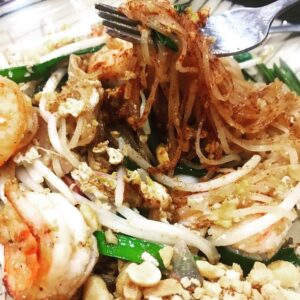
Pad Thai
Ingredients
Serving size note: In this recipe, a "cooking portion" refers to how much you will cook at one time. This amount yields the quantity of Pad Thai you would get in typical (American size) restaurant order (enough Pad Thai for 1-2 people, depending on appetite).
Pad Thai Sauce
(This yields about 1¼ cup, enough for 4-5 cooking portions. Use ¼ cup per serving portion. Store unused sauce in fridge.)
- ¾ cup tamarind concentrate
- 75 grams palm sugar, about 7 tbsp chopped, see notes for subs
- 4 tbsp fish sauce
- ¼ cup water
Aromatics - amounts are per cooking portion
- 1 tbsp garlic, chopped
- ¼ cup shallots, chopped
- ⅓ cup pressed tofu, cut into small pieces
- 1 tbsp preserved (sweet) radish, diced into small pieces
- 1 tbsp dried shrimp, diced into tiny pieces
Stir Fry - amounts are per cooking portion
- 6-8 shrimp, peeled & deveined
- 1-2 eggs
- 1½ cups garlic chives, cut to 2 inch pieces
- 4 oz rice noodles, medium width
- 1 cup bean sprouts, plus a little extra to serve on the side
How I Make It
Pad Thai Sauce
- Combine Pad Thai sauce ingredients over low heat to let the sugar disolve. If using palm sugar, chop it up into small bits to help it melt easier.
Protein
- This recipe uses shrimp, but you can use any protein you prefer - chicken, pork, tofu, beef, etc.
- Slice up your protein into bite size. If using shrimp, remove the shell and devein. Season with salt and pepper. Cook in a little oil and set aside.
Stirfying the Pad Thai
- Have all your ingredients ready and within reach as this goes quickly.
- In a large wok or pan, cook all your aromatics (tofu, shallots, raddish, dry shrimp, garlic) in a little oil for a minute or so.
- Add chives and continue stirfrying.
- Add noodles. If using dry noodles, make sure you've re-hydrated them by soaking in warm water for 30-60 mins first. Keep stir fying, and add a little water (¼-⅓ cup) if you need to. Keep stir fying. The noodles will start to soften in the water.
- Add ¼ cup Pad Thai sauce and keep stirfying.
- Add an egg or two, let it set for a few seconds in the pan, then scramble and mix it through the noodles.
- Toss in the bean sprouts and the cooked shrimp (or other protein).
- Serve with crushed peanuts (you can also toss some of this through the noodles in the wok), extra bean sprouts on the side, lime wedges, and grounded chili powder or chili flakes.
Notes
- Palm sugar can be substituted with regular sugar or light brown sugar. However each substitute presents a different level of sweetness so your sauce may be sweeter.
- Shallots can be substituted with diced red onion.
- Garlic chives can be replaced with green onions. Flavor will be a little different but visually and texturally the same.
- If using dried rice noodles, soak them in warm water for 30-60 minutes to rehydrate them before using. Then use them like you would if they were fresh noodles in this recipe.
- Shrimp can be substituted with any protein (beef, chicken, tofu, etc.)
- Personal note - I often make this without the preserved radish and dried shrimp since I don't always have those on hand. I never, ever add tofu - it is one of the foods I hate and an occasional sworn enemy. I also prefer the smaller rice noodles (the type you use in Pho) than the medium ones. As long as the Pad Thai sauce is good, it will still be bomb 😉

